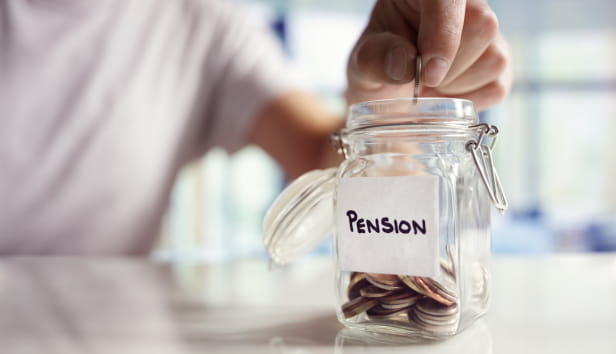This article is for general guidance only and is not financial or professional advice. Any links are for your own information, and do not constitute any form of recommendation by Saga. You should not solely rely on this information to make any decisions, and always obtain independent, professional advice for your own particular situation. All information in this article is correct at the time of publishing, but laws, entitlements, tax treatments and allowances may change in the future.
If you’re currently earning little interest on your savings, you’re not alone. Around £275 billion is sitting in accounts earning zero interest, Bank of England data shows.
Switching your cash to a higher-rate savings account is a simple fix that will immediately make your money start working harder. But it’s worth pausing to consider if there are even better uses for your capital.
From clearing expensive debts to boosting your pension pot with valuable tax relief, there are financial moves that could save or make you more money in the long run. Many of these are worthwhile even if you’re already earning a decent interest rate on your savings, as we’ll explain.
What’s on this page:
If you have an outstanding balance on a credit card, loan or any other type of consumer credit, it’s normally best to use your savings to reduce your debts. This is because the interest you pay on borrowing is often more than the amount you can earn on your savings.
According to the latest Moneyfacts data, the average credit card purchase APR (including card fees) stands at an all-time high of 35.7%, while the best rate on a £10,000 loan over a five-year repayment term stands at 6%, according to the consumer group Which?.
In comparison, at the time of writing, easy-access savings accounts are paying up to 5%. And the prize rate on Premium Bonds is now 3.6% (and most people get a lower return than that.) So check the interest rate on any loan or credit you’re paying off, to see if using savings can be beneficial.
But while paying off your debts is likely to be more cost-effective than saving, Simon Trevethick, head of communications at debt advice charity StepChange, points out that you might think about holding some cash in a savings account.
“If using up your savings could mean you’d need to take out further credit in the future, it may be a sensible move to keep a savings buffer, as long as you’re meeting your contractual debt repayments.”
The same goes if you still have a mortgage. Your money could be working harder if you make overpayments than if you stash it in a savings account.
Most mortgages will allow you to overpay 10% of your outstanding balance each year (although some allow more, so it’s worth checking your terms and conditions) without charging a fee. By overpaying your mortgage, you’ll pay off your loan faster and potentially save thousands in interest. You can choose to pay in lump sums or increase your monthly payments.
The pandemic and cost-of-living crisis highlighted the need for emergency savings. Life can throw some surprising curveballs our way.
Having an emergency fund can help you financially prepare for the unexpected, whether that’s energy bills shooting up, being unable to work or losing your job.
If you have money set aside for emergencies, you’re less likely to experience financial problems or need to borrow at a high interest rate if your circumstances change.
Sarah Coles, Hargreaves Lansdown’s head of personal finance, says that while you’re working you should have an emergency savings fund big enough to cover three to six months’ worth of essential spending.
The idea is that you can cover the basics if the worst was to happen, or you could stretch to unexpected costs if you were hit by more than one in quick succession.
“When you retire, the rule of thumb rises to one to three years’ worth of savings available. When you’re on a fixed income it can be more difficult to meet extra expenses, and more difficult to rebuild your fund quickly,” she adds.
“If you’re also taking an income from your pension through drawdown, you may need this fund to supplement your income at times when income or growth from your investments falls short.”
These savings should be somewhere that you can call on instantly – but it's smart to still shop around to get the best interest rate on them too.

If you have money in a savings account, check the interest rate you’re getting. Despite recent cuts to the Bank of England base rate, it’s still well above the rock-bottom rates we saw three or four years ago.
So make sure your cash savings are keeping up – especially as inflation remains significantly above the Bank of England’s 2% target.
Anna Bowes, founder of SavingsChampion, says you should always check the terms and conditions, as not all easy-access accounts live up to their name.
So check carefully to make sure that you earn the interest you are expecting. “Many of the top accounts restrict the number of penalty-free withdrawals that can be made each year – which means that they may not be appropriate for all. Usually there will be a penalty if you make too many withdrawals,” she adds.
There are several types of savings accounts. Fixed-rate savings accounts (or ‘fixed-rate bonds’) usually pay more interest than easy access accounts. However, you’ll need to commit to locking your money away for a year or more to benefit from a higher rate.
You should also consider a cash ISA for cash savings, as interest is tax-free. The maximum you can pay into ISAs is £20,000 per tax year, including investment and cash ISAs. Like with ordinary savings accounts, you can find easy-access or fixed cash ISAs.
If you’re looking to save each month, then ‘regular savings’ accounts have competitive rates but, like some easy-access options, there will be limits on how much you can save each month.
You'll often see a restriction on how much you can pay in, and withdrawals can be limited – so always check the small print.
If you have Premium Bonds, or are considering getting them, we’ve got some tips on when they might and might not be a good choice.
With the state pension age rising, and people working longer, you’ll likely rely on personal pension savings to boost your income in retirement. We explain here how much you’re likely to need for a comfortable retirement.
Pensions are the most tax-efficient way to save for retirement. You get tax relief on private pension contributions that’s equivalent to the rate of income tax you pay. This means that it only costs a basic rate taxpayer £80 to invest £100, while higher rate taxpayers only need to pay £60.
If you pay a higher rate of tax you may need to claim back some of your tax relief through your self-assessment tax return, depending on your pension scheme. Check with your pension provider if you’re not sure.
Any money you pay into your pension can be accessed from the age of 55 (rising to 57 in 2028). Each year you can pay up to 100% of your earnings into your pension to get tax relief (or up to £60,000, the annual allowance for most).
If you want to bump up your contributions, you can either increase monthly contributions to a personal or workplace scheme, or make lump sum payments (or both).
Just be aware that if you’re over 55 and have already made a taxable withdrawal from your pension, you’ll have a lower allowance for paying into your retirement scheme. This is known as the money purchase annual allowance (MPAA) – and it's just £10,000 a year.
If you're looking to pay more than this amount into a pension when you’ve triggered the MPAA, then you should seek advice to see if this is the best plan for you.



Current rates, when you can claim, eligibility, and how to check & boost your entitlement.

Learn how much pension you need & get tips to boost your savings if you're short.



Enjoy the freedom to withdraw your savings at any time.
